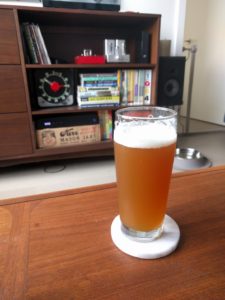Brew Date: June 10, 2017 Bottled: June 30, 2017
ABV: 4.5% IBU: 22

Gramarye is a table-strength saison style ale. In order to provide character and body in the low-ABV package, it is made with Vienna as the base malt and both malted and flaked rye. Kazbek hops were chosen for their combination of noble character as well as bright citrus flavour. Imperial’s B56 yeast strain is quickly becoming my go-to base for farmhouse ales as I really enjoy its ester/phenol character.
I’m fermenting 5 of the 7.5 gallons as a clean version using B56, while the 3-gallon glass carboy recently emptied (failed bière de nöel batch) will be fermented with a mixed culture propogated from two Holy Mountain saisons (The Seer & Grey Tower Blend 3). I’ve propped up the Saccharomyces content of this mixed culture with a vial of B56 I have in the fridge, saved from my Feburary brew of Dorée.
Batch size: 7.50 gallons (split per below)
OG: 1.038
FG: 1.003 (1.000 for Reserve)
Grist Details:
40% Vienna malt (4.00 lbs)
23% Rye malt (2.30 lbs)
23% Pilsner malt (2.30 lbs)
8% Flaked rye (0.80 lbs)
4% Dark Munich (0.40 lbs)
2% Acid malt (0.20 lbs)
Hopping:
2.25 grams CO2 extract at 90 min (15 AAU)
0.50 oz Kazbek at 40 min (6 AAU)
1.00 oz Kazbek at 10 min (3 AAU)
0.50 oz Kazbek – dry hop
Additional:
7.5 g Calcium chloride added to mash water
5 g Gypsum added to mash water
Fermentation:
5-gal “Clean” version: Imperial B56 Rustic (200B cell can, no starter), pitch at 65F, let free rise in 72F ambient room.
Liquid temperature 75F at 24h, strong CO2 activity.
2.5 gal “Reserve 2017” version: Mixed culture of saved Imperial B56 plus propped dreg cultures from Holy Mountain bottles.
Liquid temperature 73F at 24h, high krausen (fall started by 30-32h).
Brew Day Notes:
Made a 250mL starter for the Holy Mtn dregs with 0.5 oz of DME on Monday. By Wednesday there was some activity, though pretty low intensity. No krausen formed.
Brewed on patio with Grainfather. Started heating 4.25 gal of mash water at 10:00am. Added 3/4 tsp of Gypsum and 1/4 tsp CaCl to mash water. Added further 1/4 tsp each Gypsum and CaCl to 5.00 gals sparge water. Definitely noticed the lack of flow through the grain bed for the first 15-20 minutes of mash recirculation, despite the rice hulls. Sparge drained well, though.
Boiled for 105 minutes before recirculating through the counterflow chiller to sterilize. Collected 2.5 gallons of 1.039 wort into the glass carboy and 4.0 gallons into the Ss bucket. Hit each with 10-15 seconds of O2. Pitch temp was 68F and kept at ambient temps (about 72F).
Taste test at 2.5 wks (Tuesday evening) in primary tasted pretty good although those volatile aroma compounds I’m starting to associate with this yeast were there at first. Dry hopped with 0.5 oz Kazbek on Wednesday morning. Gravity down to 1.003.
Tasting Notes:
[July 14, 2017] First bottle, good carbonation. I carb’d this higher than most (3.5 volumes CO2) since it finished quite dry. Fruity yeast esters and a noble hop character lead the way, though are balanced. Despite the Vienna base and fair amount of rye, the malt character is subdued. However, they do help mask the low gravity of this beer – it drinks like it is 6%.

